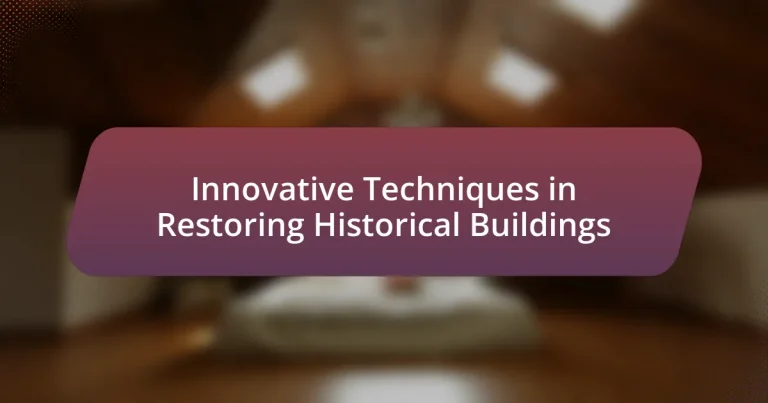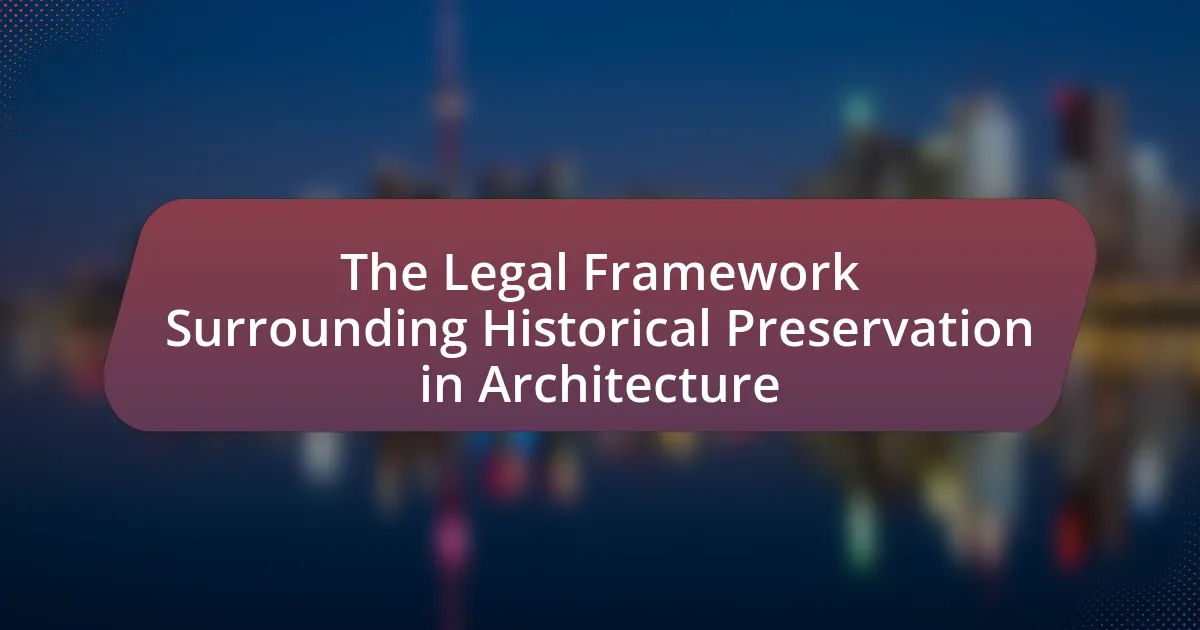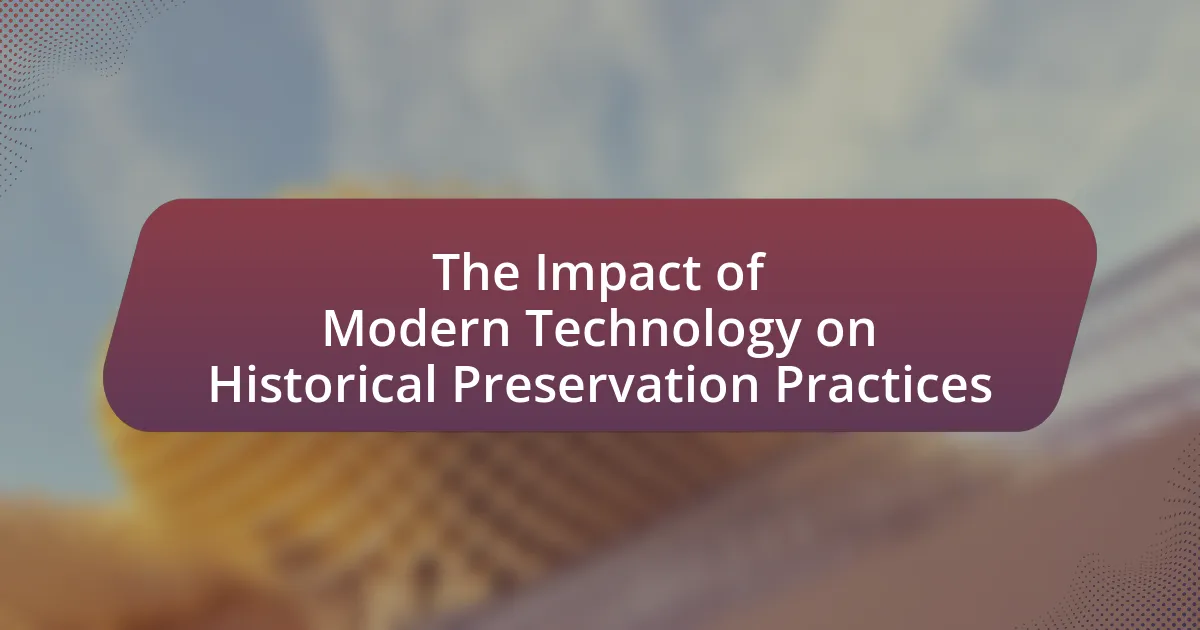Innovative techniques in restoring historical buildings encompass advanced materials, digital documentation, and sustainable practices aimed at enhancing structural integrity while preserving historical aesthetics. Key methods include the use of 3D scanning, Building Information Modeling (BIM), and modern materials like nanomaterials and bio-based composites, which improve accuracy and durability in restoration efforts. The article also highlights the importance of authenticity, sustainability, and the integration of technology in restoration practices, as well as the challenges restorers face and the best practices for successful implementation. Examples such as the restoration of the Notre-Dame Cathedral illustrate the effectiveness of these innovative approaches in maintaining cultural heritage.

What are Innovative Techniques in Restoring Historical Buildings?
Innovative techniques in restoring historical buildings include the use of advanced materials, digital documentation, and sustainable practices. Advanced materials, such as nanomaterials and bio-based composites, enhance structural integrity while preserving historical aesthetics. Digital documentation techniques, like 3D scanning and Building Information Modeling (BIM), allow for precise restoration planning and visualization. Sustainable practices, including energy-efficient retrofitting and the use of reclaimed materials, ensure that restorations are environmentally friendly. These methods have been validated by successful projects, such as the restoration of the Notre-Dame Cathedral, which employed modern technology to preserve its historical significance while enhancing safety and sustainability.
How do these techniques differ from traditional restoration methods?
Innovative techniques in restoring historical buildings differ from traditional restoration methods primarily in their use of advanced technology and materials. Traditional methods often rely on manual labor and conventional materials, which can limit precision and effectiveness. In contrast, innovative techniques incorporate digital tools such as 3D scanning and modeling, allowing for more accurate assessments and restorations. For example, the use of laser scanning can capture intricate details of a structure, enabling restorers to create precise replicas of damaged elements. Additionally, modern materials like carbon fiber and advanced polymers provide enhanced durability and flexibility compared to traditional materials, which can improve the longevity of restorations. These advancements lead to more efficient, sustainable, and accurate restoration processes, ultimately preserving historical integrity while adapting to contemporary standards.
What are the key principles behind innovative restoration techniques?
The key principles behind innovative restoration techniques include authenticity, sustainability, and integration of modern technology. Authenticity ensures that restoration efforts respect the original materials and craftsmanship, preserving the historical integrity of the building. Sustainability focuses on using eco-friendly materials and methods that minimize environmental impact, such as energy-efficient systems and renewable resources. Integration of modern technology involves employing advanced tools and techniques, like 3D scanning and digital modeling, to enhance precision in restoration processes. These principles collectively aim to balance historical preservation with contemporary needs, ensuring that restored buildings remain functional and relevant in today’s context.
How do modern materials play a role in these techniques?
Modern materials significantly enhance the techniques used in restoring historical buildings by providing improved durability, flexibility, and compatibility with original structures. For instance, the use of advanced composites and synthetic resins allows for repairs that are both strong and lightweight, minimizing the structural load on aging buildings. Additionally, modern materials like breathable membranes and lime-based mortars facilitate moisture management, which is crucial for preserving the integrity of historical masonry. Research published in the Journal of Architectural Conservation highlights that these materials can extend the lifespan of restorations while maintaining aesthetic fidelity to the original design, demonstrating their effectiveness in contemporary restoration practices.
Why is innovation important in the restoration of historical buildings?
Innovation is important in the restoration of historical buildings because it enables the integration of modern technology and materials that enhance preservation while maintaining authenticity. For instance, advanced techniques such as 3D scanning and digital modeling allow for precise documentation and reconstruction of deteriorated elements, ensuring that restorations are accurate to the original design. Additionally, the use of sustainable materials and energy-efficient systems not only preserves the structural integrity but also reduces the environmental impact of restoration projects. This approach is supported by case studies, such as the restoration of the Notre-Dame Cathedral, where innovative methods were employed to address fire damage while respecting historical significance.
What challenges do restorers face that innovation can address?
Restorers face challenges such as material degradation, structural instability, and the need for precise historical accuracy, which innovation can address through advanced materials and technologies. For instance, the use of nanotechnology can enhance the durability of restoration materials, while 3D scanning and printing allow for accurate replication of historical elements. Additionally, innovations in structural engineering can provide solutions for stabilizing aging buildings without compromising their historical integrity. These advancements not only improve the effectiveness of restoration efforts but also ensure that the cultural significance of historical buildings is preserved for future generations.
How does innovation enhance the preservation of cultural heritage?
Innovation enhances the preservation of cultural heritage by introducing advanced technologies and methods that improve restoration accuracy and efficiency. For instance, 3D scanning and printing allow for precise documentation and replication of historical artifacts, ensuring that original details are maintained during restoration processes. Additionally, the use of non-invasive materials and techniques, such as laser cleaning and digital modeling, minimizes damage to original structures while effectively addressing deterioration. These innovations not only preserve the physical integrity of cultural heritage sites but also facilitate better public engagement and education through interactive experiences, such as virtual reality tours that showcase historical contexts.

What are some examples of Innovative Techniques in Restoring Historical Buildings?
Some examples of innovative techniques in restoring historical buildings include the use of 3D scanning and printing, which allows for precise documentation and replication of architectural elements. Additionally, the application of advanced materials such as carbon fiber for structural reinforcement enhances stability while preserving original aesthetics. Another technique is the integration of modern energy-efficient systems, like geothermal heating and cooling, which reduces environmental impact without compromising historical integrity. These methods are validated by successful restoration projects, such as the use of 3D printing in the restoration of the Notre-Dame Cathedral, where intricate stone carvings were replicated to match the original design.
How is 3D printing used in restoration projects?
3D printing is used in restoration projects to create accurate replicas of damaged or missing architectural elements. This technology allows for the precise reproduction of intricate details found in historical structures, enabling restorers to replace components such as sculptures, moldings, and decorative features that may have been lost over time. For example, the use of 3D printing in the restoration of the Notre-Dame Cathedral involved creating replicas of its unique stone carvings, which were essential for maintaining the building’s historical integrity. This method not only speeds up the restoration process but also reduces costs compared to traditional restoration techniques, making it a valuable tool in preserving cultural heritage.
What are the benefits of using 3D printing for historical accuracy?
Using 3D printing enhances historical accuracy by enabling precise replication of artifacts and architectural elements. This technology allows for the creation of detailed models that can accurately reflect the original materials, dimensions, and designs of historical structures. For instance, a study by the University of Southern California demonstrated that 3D printing can reproduce intricate details of historical artifacts, which aids in both preservation and education. Furthermore, 3D printing facilitates the restoration process by providing exact replicas that can replace damaged or missing components without compromising the integrity of the original structure.
What limitations exist with 3D printing in restoration?
3D printing in restoration faces several limitations, including material constraints, precision issues, and regulatory challenges. The materials used in 3D printing may not match the original materials in terms of durability and aesthetic qualities, which can affect the authenticity of the restoration. Additionally, the precision of 3D printing can vary, leading to discrepancies in dimensions that may not align with historical specifications. Regulatory challenges also arise, as many restoration projects must adhere to strict guidelines that may not accommodate the use of 3D-printed components. These limitations highlight the need for careful consideration when integrating 3D printing into restoration practices.
What role does digital technology play in restoration?
Digital technology plays a crucial role in the restoration of historical buildings by enhancing precision, efficiency, and accessibility in the restoration process. Technologies such as 3D scanning and modeling allow for accurate documentation of existing structures, enabling restorers to create detailed digital replicas that inform restoration efforts. For instance, the use of Building Information Modeling (BIM) facilitates the integration of various data sources, improving project management and collaboration among stakeholders. Additionally, digital tools like augmented reality (AR) provide visualizations that help stakeholders understand proposed changes, ensuring that restorations are both historically accurate and contextually appropriate. These advancements demonstrate that digital technology significantly improves the quality and effectiveness of restoration projects.
How do virtual reality and augmented reality assist in planning restorations?
Virtual reality (VR) and augmented reality (AR) significantly enhance the planning of restorations by providing immersive visualizations and interactive simulations of historical buildings. These technologies allow architects and restoration experts to visualize potential changes and assess the impact of various restoration strategies in a realistic environment. For instance, VR can create a fully immersive 3D model of a building, enabling stakeholders to explore the space as if they were physically present, which aids in identifying structural issues and design flaws before actual work begins. AR, on the other hand, overlays digital information onto the real-world view of a building, allowing planners to see how proposed changes would look in situ, facilitating better decision-making. Studies have shown that using VR and AR in restoration projects can lead to improved accuracy in planning and a reduction in costly errors, as these technologies provide a clearer understanding of the building’s condition and the effects of proposed interventions.
What software tools are commonly used in innovative restoration techniques?
Commonly used software tools in innovative restoration techniques include Building Information Modeling (BIM) software, such as Autodesk Revit, and 3D modeling tools like SketchUp. These tools facilitate detailed planning and visualization of restoration projects, allowing for accurate assessments of structural integrity and historical accuracy. Additionally, Geographic Information Systems (GIS) software, such as ArcGIS, is utilized for spatial analysis and mapping of historical sites, enhancing the understanding of their context and significance. The integration of these software tools supports efficient project management and collaboration among architects, engineers, and preservationists, ensuring that restoration efforts are both innovative and respectful of historical integrity.

What are the best practices for implementing Innovative Techniques in Restoring Historical Buildings?
The best practices for implementing innovative techniques in restoring historical buildings include conducting thorough research, utilizing advanced materials, and ensuring compliance with preservation standards. Conducting thorough research involves understanding the building’s historical significance, architectural style, and previous restoration efforts, which informs the approach to restoration. Utilizing advanced materials, such as breathable membranes and eco-friendly products, enhances durability while respecting the building’s integrity. Ensuring compliance with preservation standards, such as those set by the National Park Service or local heritage organizations, guarantees that restoration efforts maintain the building’s historical authenticity. These practices are supported by case studies demonstrating successful restorations that balance innovation with preservation, such as the restoration of the Notre-Dame Cathedral, which incorporated modern techniques while adhering to historical guidelines.
How can restorers ensure the integrity of historical accuracy while innovating?
Restorers can ensure the integrity of historical accuracy while innovating by adhering to established conservation principles and utilizing advanced technologies that respect original materials and techniques. The Venice Charter of 1964 emphasizes the importance of preserving the authenticity of cultural heritage, guiding restorers to prioritize historical accuracy in their work. By employing methods such as 3D scanning and digital modeling, restorers can analyze and replicate original features without compromising the building’s historical context. Additionally, using materials that are compatible with the original construction ensures that any innovations do not detract from the building’s historical significance. This approach is supported by case studies, such as the restoration of the Notre-Dame Cathedral, where modern techniques were integrated with traditional craftsmanship to maintain historical integrity.
What guidelines should be followed when selecting materials for restoration?
When selecting materials for restoration, it is essential to prioritize compatibility with the original materials, ensuring that new materials do not adversely affect the structural integrity or aesthetic value of the historical building. This involves analyzing the physical and chemical properties of existing materials, such as their durability, porosity, and moisture absorption rates, to choose suitable replacements or supplements. Additionally, historical accuracy should be maintained by sourcing materials that match the original in appearance and composition, which can be verified through historical documentation or scientific analysis. For instance, using lime-based mortars instead of modern cement can prevent damage to older masonry due to differing expansion rates. Furthermore, sustainability should be considered, favoring materials that are locally sourced and environmentally friendly to minimize the ecological impact of the restoration process.
How can collaboration with historians enhance innovative restoration efforts?
Collaboration with historians enhances innovative restoration efforts by integrating historical accuracy and context into the restoration process. Historians provide critical insights into the original architectural styles, materials, and cultural significance of historical buildings, which informs restoration techniques that respect the integrity of the structure. For example, the restoration of the Notre-Dame Cathedral in Paris involved historians to ensure that the rebuilding efforts adhered to the original Gothic design principles and materials used in the 12th century. This collaboration not only preserves the historical value but also fosters innovative methods that align with contemporary standards while honoring the past.
What are common pitfalls to avoid in innovative restoration projects?
Common pitfalls to avoid in innovative restoration projects include inadequate planning, insufficient stakeholder engagement, and neglecting historical integrity. Inadequate planning often leads to budget overruns and project delays, as seen in the restoration of the Notre-Dame Cathedral, where initial estimates failed to account for the complexity of the structure. Insufficient stakeholder engagement can result in community pushback and lack of support, which was evident in the restoration efforts of the Sydney Opera House, where local input was crucial for acceptance. Neglecting historical integrity can compromise the authenticity of the restoration, as demonstrated in various projects where modern materials clashed with traditional aesthetics, ultimately diminishing the historical value of the site.
How can improper use of technology affect restoration outcomes?
Improper use of technology can significantly compromise restoration outcomes by leading to structural damage, aesthetic discrepancies, and loss of historical integrity. For instance, using inappropriate materials or methods can result in irreversible alterations to a building’s original features, as evidenced by cases where modern adhesives have caused deterioration of historical masonry. Additionally, reliance on inaccurate data from technology can misguide restoration efforts, leading to decisions that do not align with preservation standards, such as the Secretary of the Interior’s Standards for the Treatment of Historic Properties. These standards emphasize the importance of using technology that respects and maintains the original character of historical buildings, highlighting that improper application can ultimately undermine the goals of restoration.
What are the risks of prioritizing innovation over historical fidelity?
Prioritizing innovation over historical fidelity in restoring historical buildings can lead to the loss of cultural heritage and authenticity. When modern techniques and materials are favored, the original architectural elements, craftsmanship, and historical context may be compromised or entirely erased. For example, the use of contemporary materials like synthetic composites can detract from the original aesthetic and structural integrity of a building, as seen in the restoration of the Notre-Dame Cathedral, where modern interventions sparked debate over their impact on historical authenticity. Additionally, this approach can alienate communities that value their historical narratives, resulting in public backlash and diminished trust in preservation efforts.
What practical tips can restorers follow to successfully implement innovative techniques?
Restorers can successfully implement innovative techniques by adopting a systematic approach that includes thorough research, collaboration with experts, and the use of advanced materials. Conducting detailed historical research ensures that restorers understand the original construction methods and materials, which is crucial for maintaining authenticity. Collaborating with architects, engineers, and conservation specialists allows restorers to integrate modern technology with traditional practices effectively. Utilizing advanced materials, such as breathable paints and eco-friendly adhesives, can enhance the durability and sustainability of restorations while preserving the building’s historical integrity. These strategies are supported by case studies demonstrating successful restorations that blend innovation with preservation, such as the restoration of the Notre-Dame Cathedral, where modern techniques were employed to ensure structural integrity while respecting historical significance.





